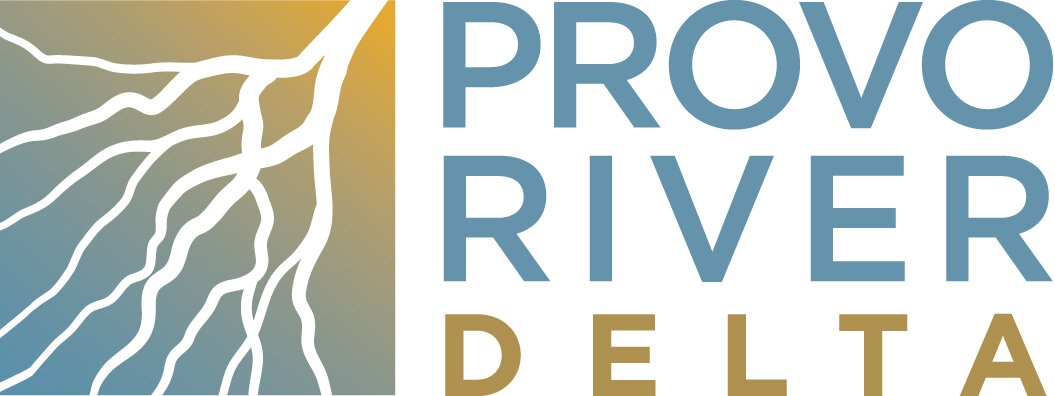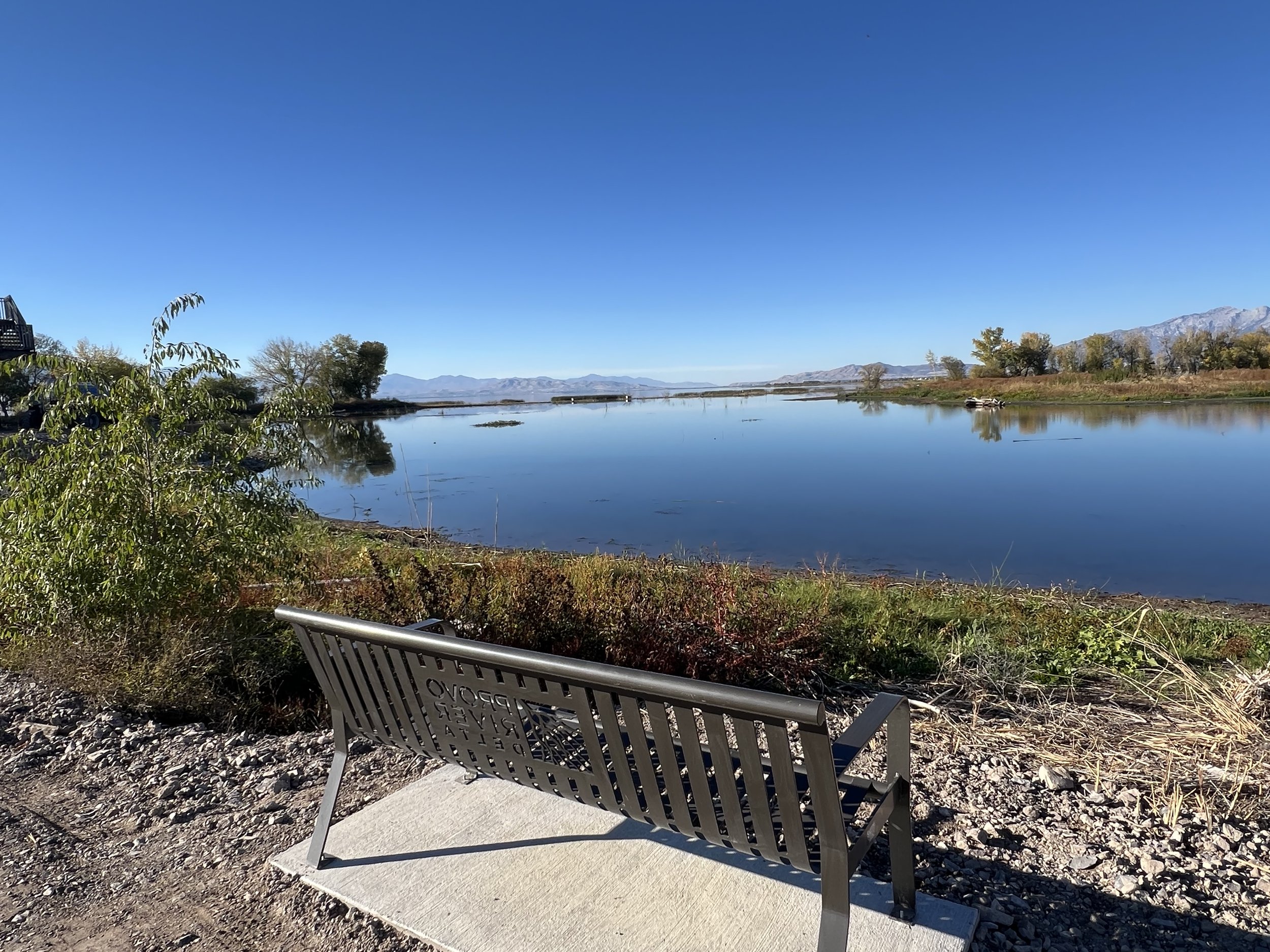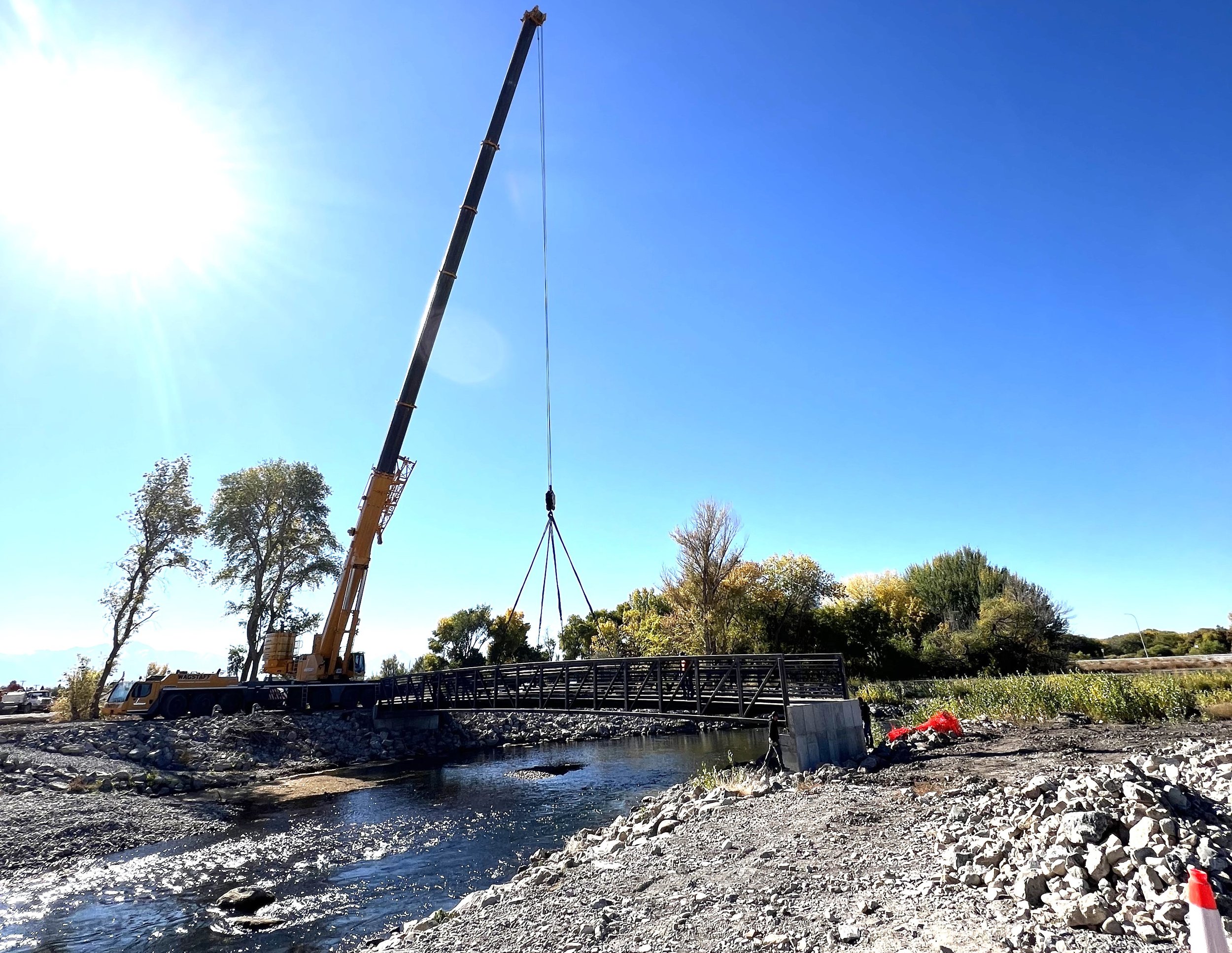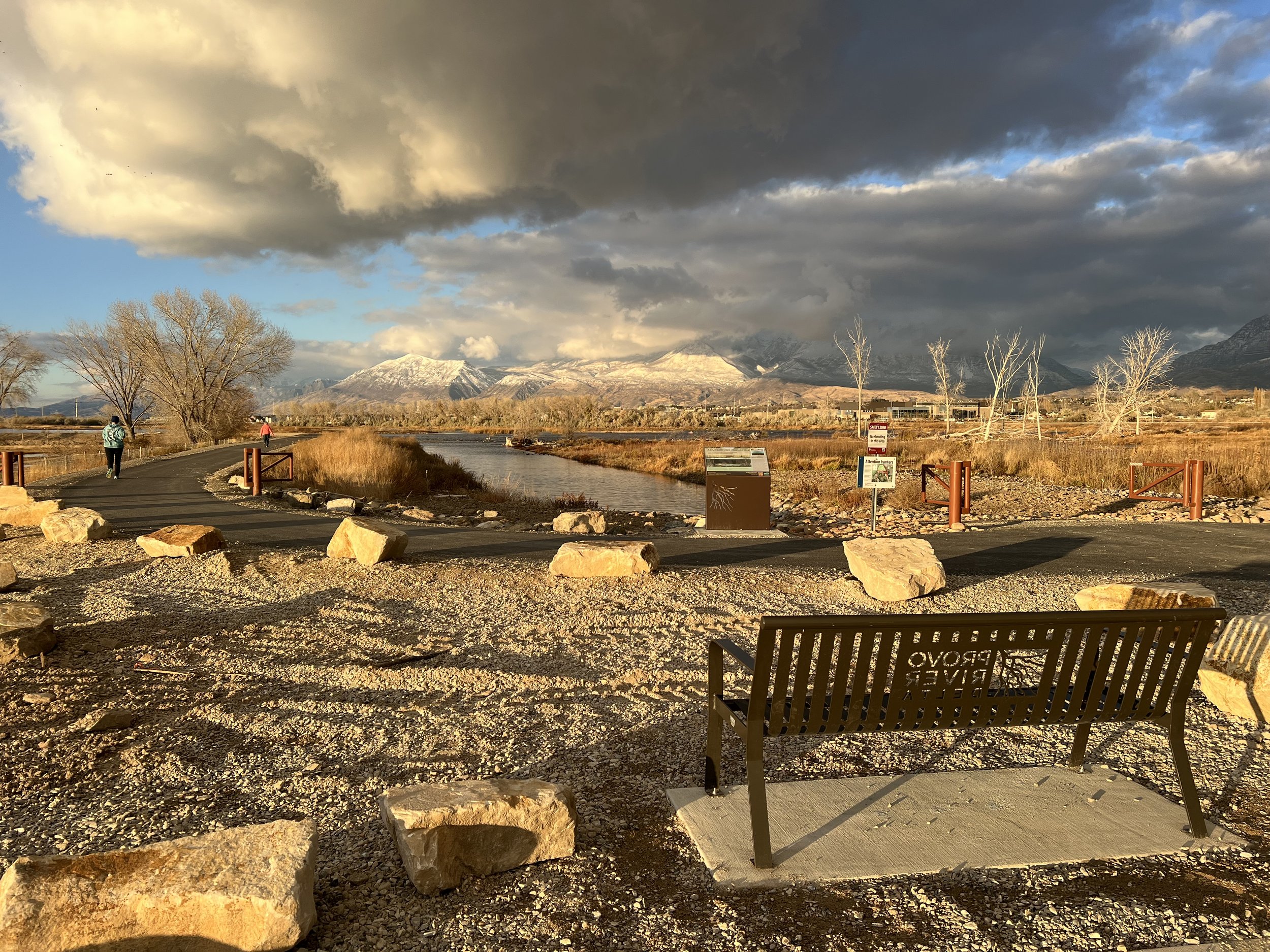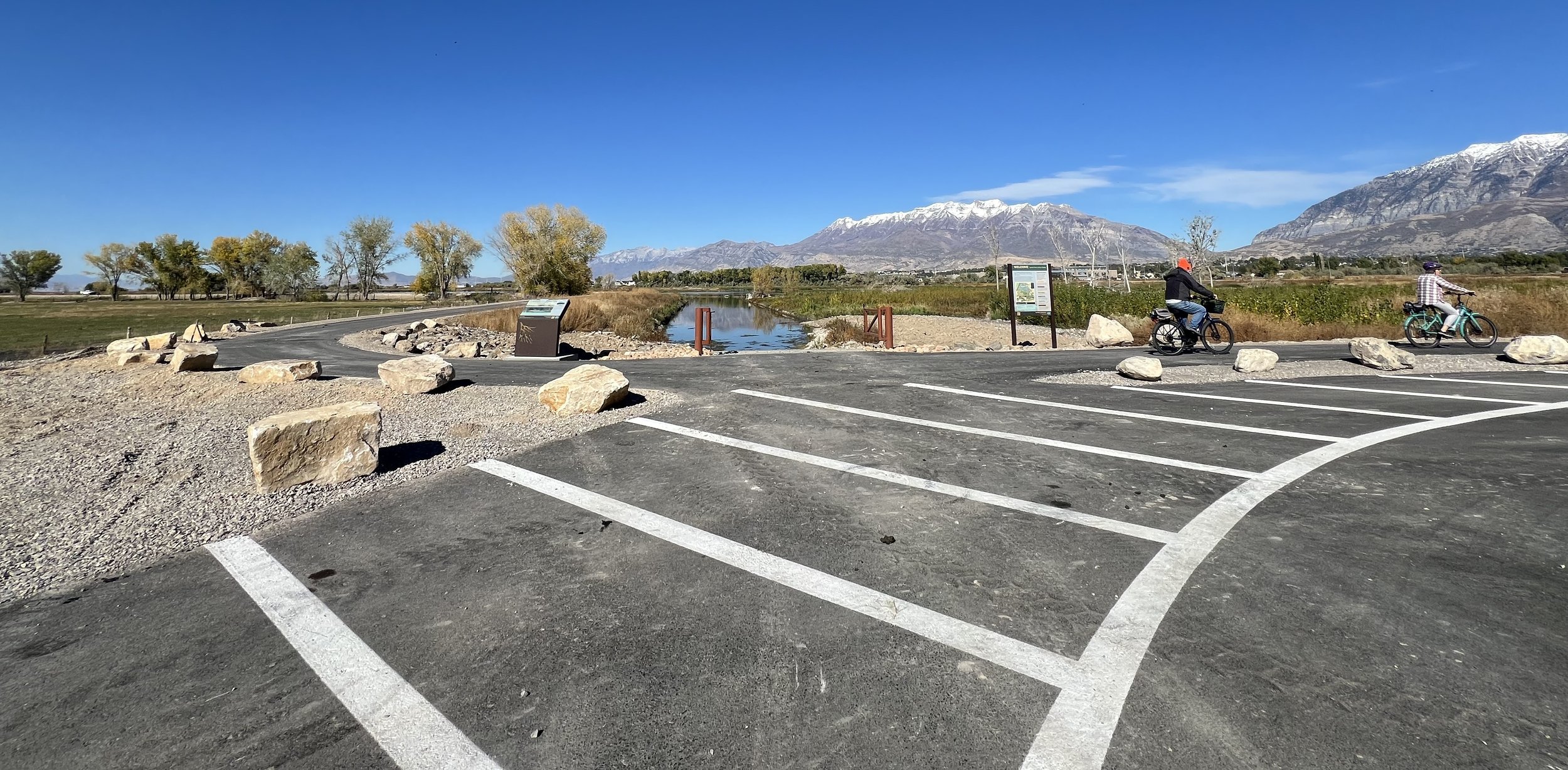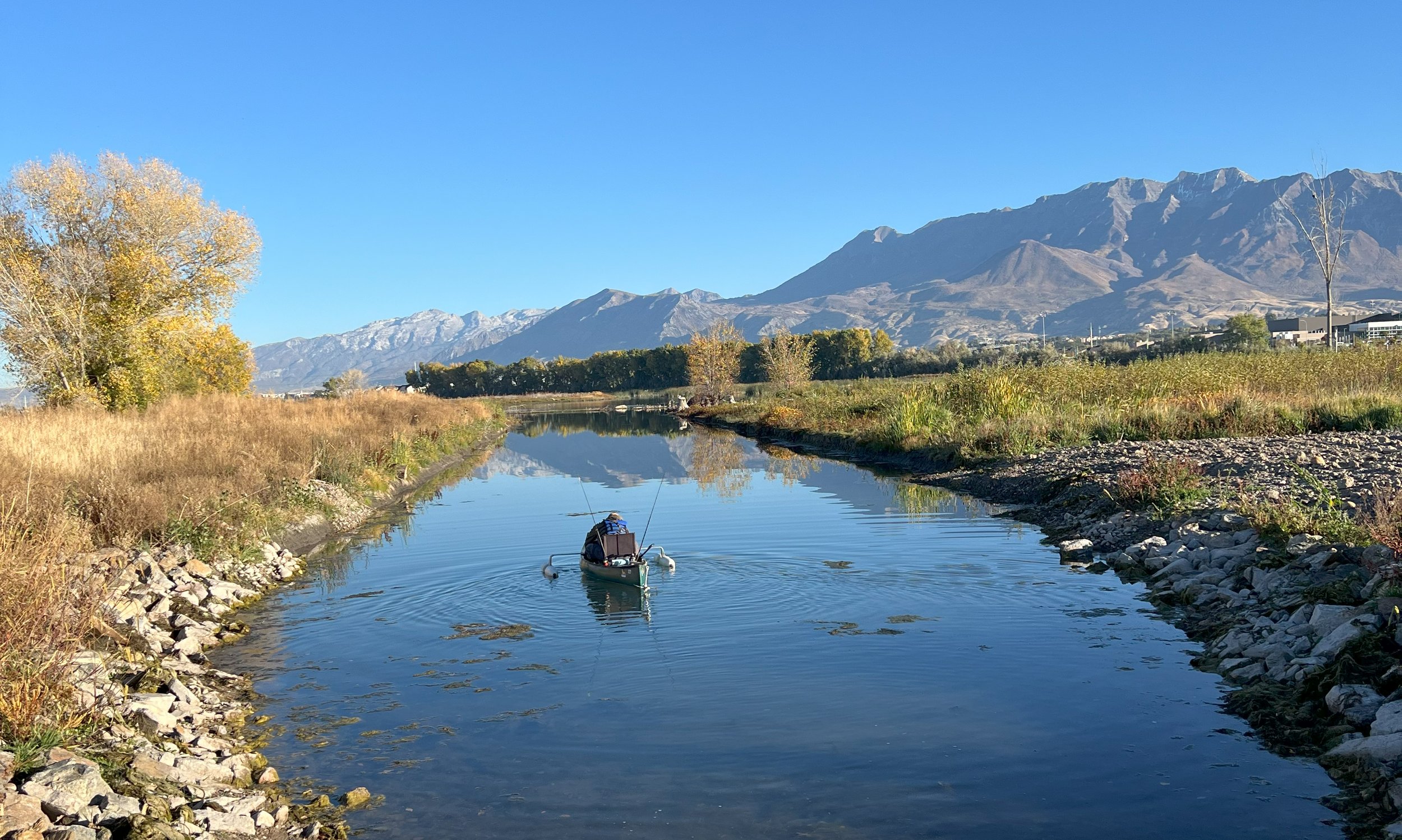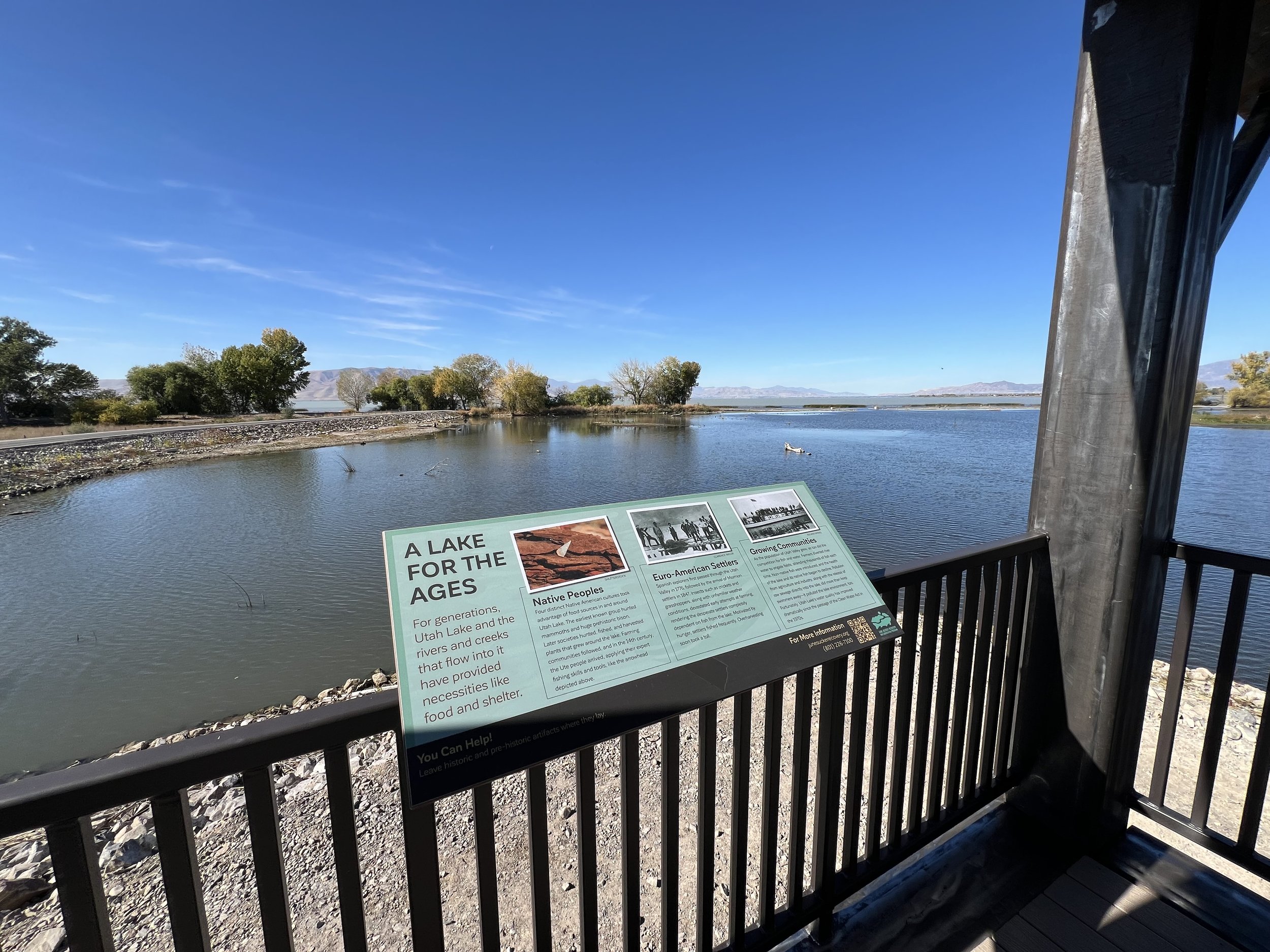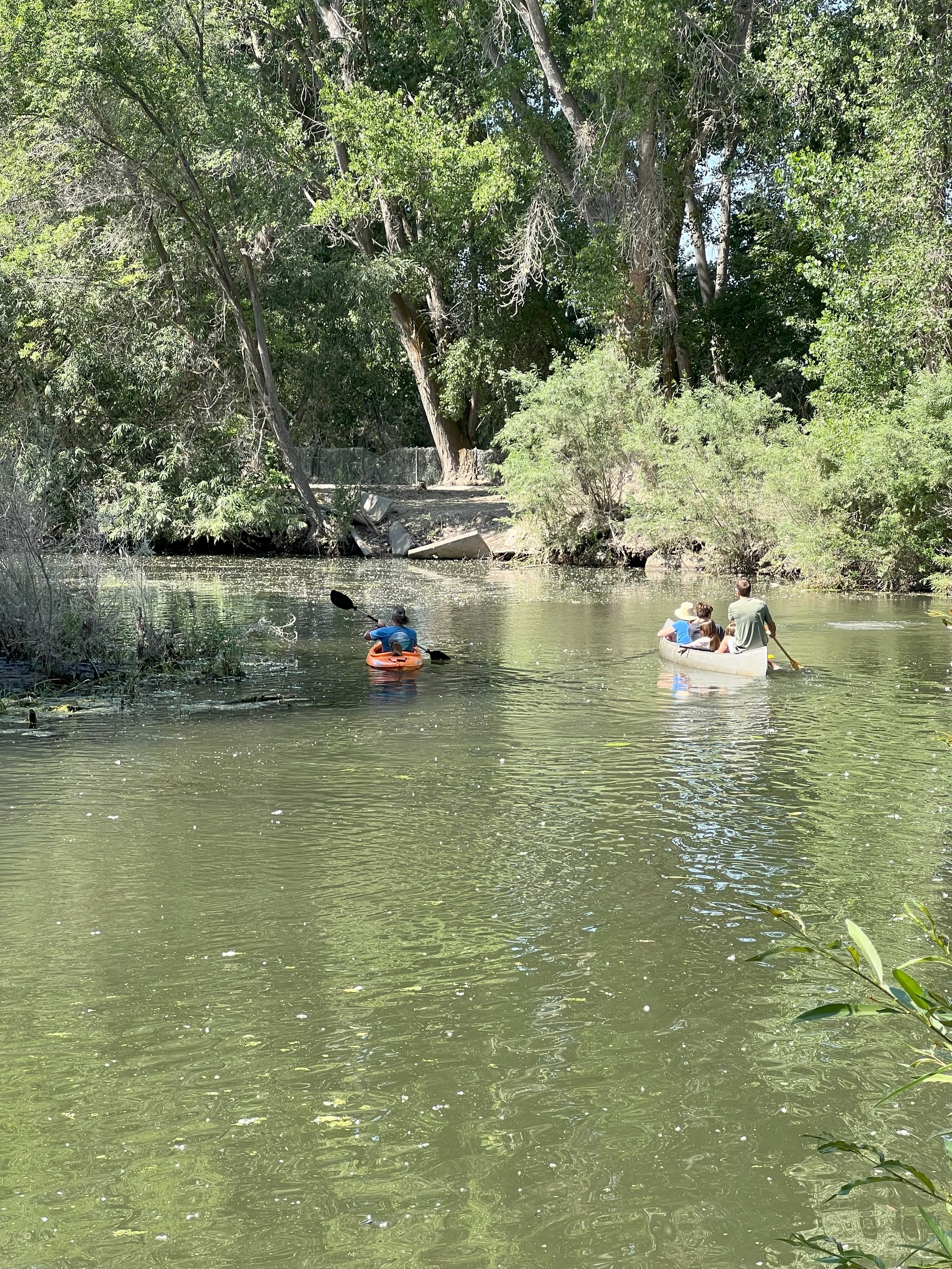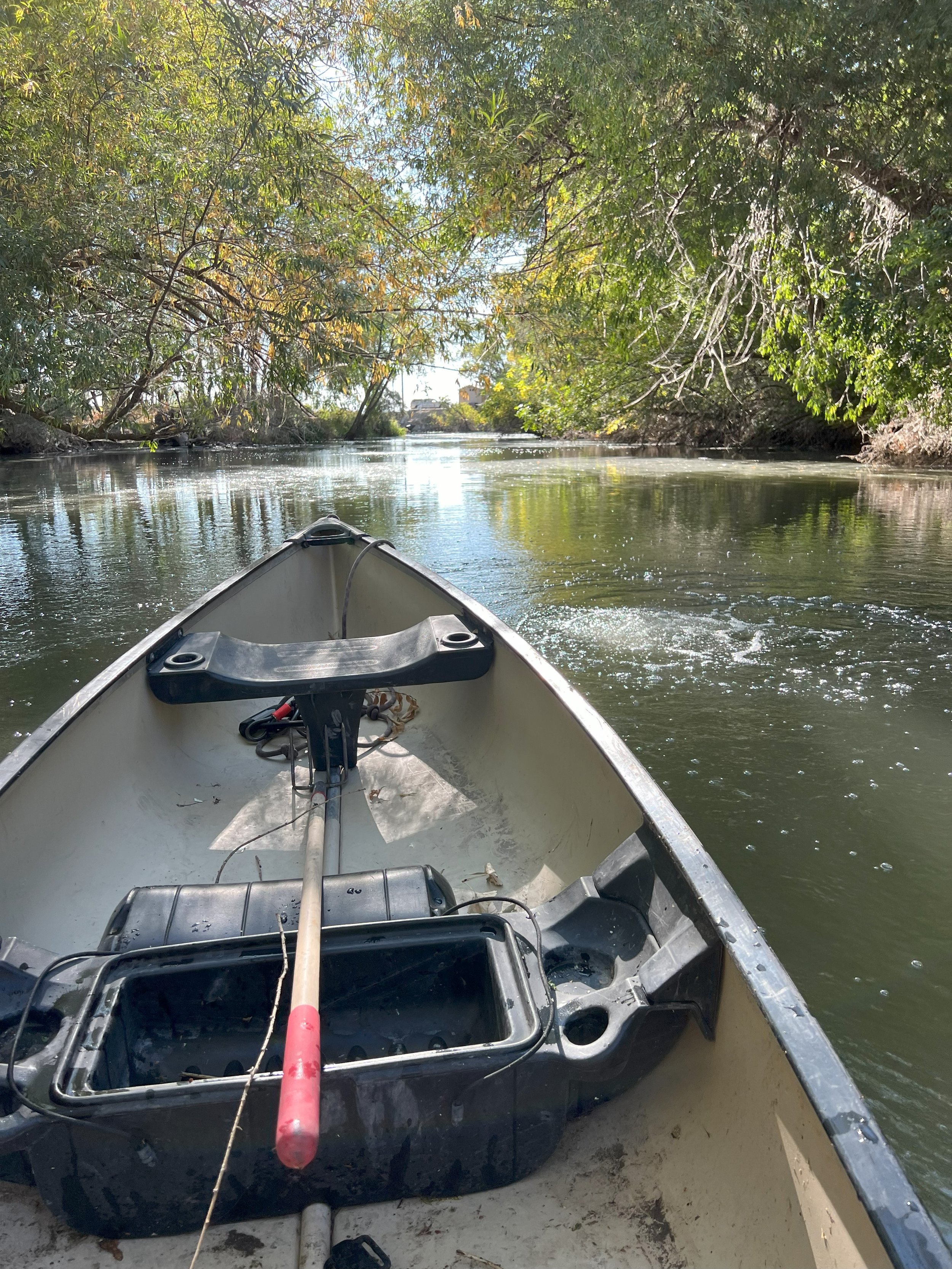Provo River Delta Restoration Project
2024 A Year In Review
View looking northwest of the lower Provo River as it flows through its reconstructed channel and new delta into Utah Lake. The original river channel is visible on the left. © December 2024, Utah By Air.
Delta GO!
The Provo River Delta opened to the public on a gorgeous Saturday, (October 26, 2024) with a celebration at the delta’s new Skipper Bay Trailhead. Members of the public came out to explore the expanded Skipper Bay Trail, take in the vistas from the new viewing tower and pick up a treat or kernel of knowledge from those tabling at the event. Special thanks goes to all event participants who contributed their time, resources and knowledge to make the day a fun success!











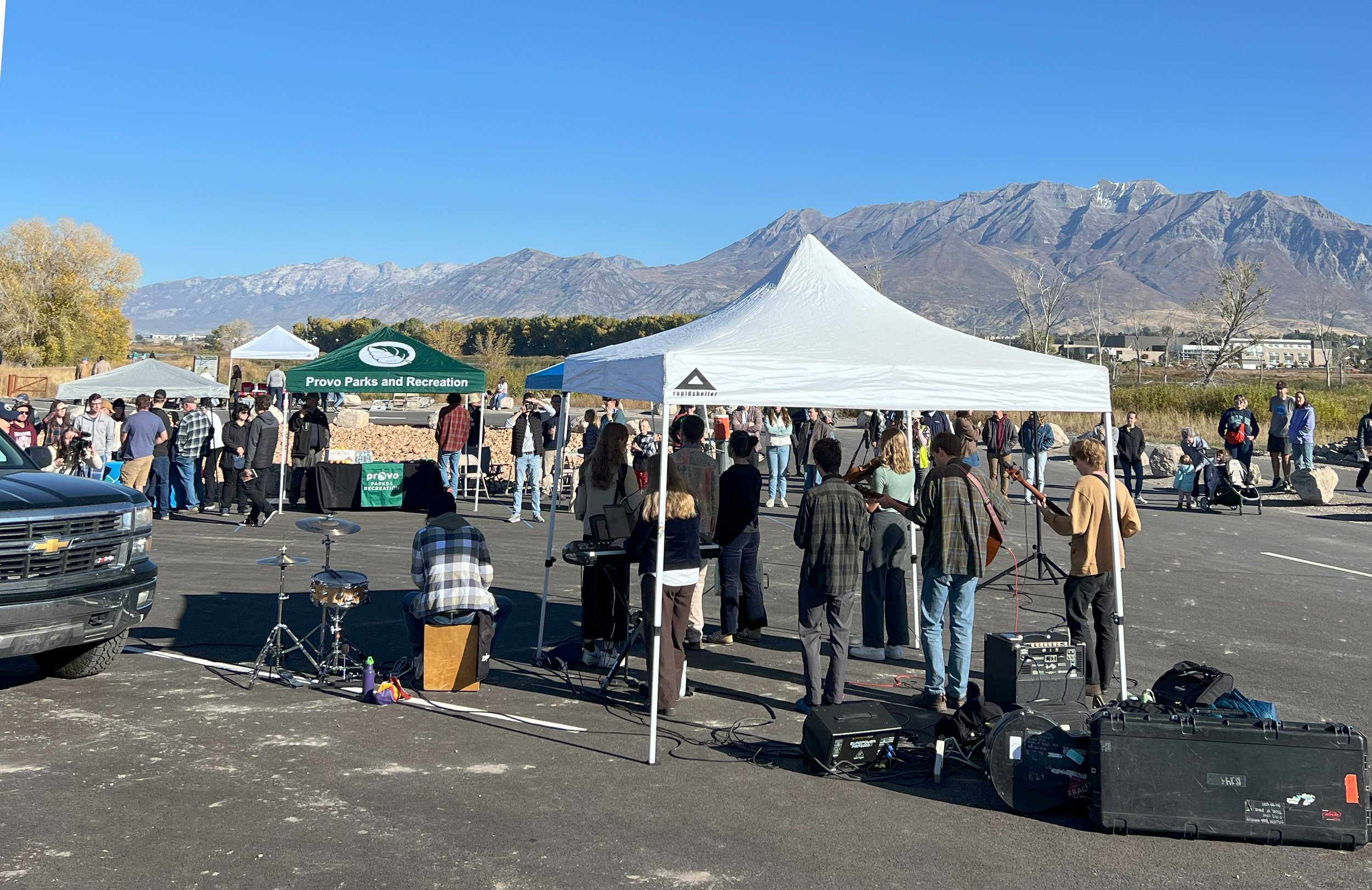
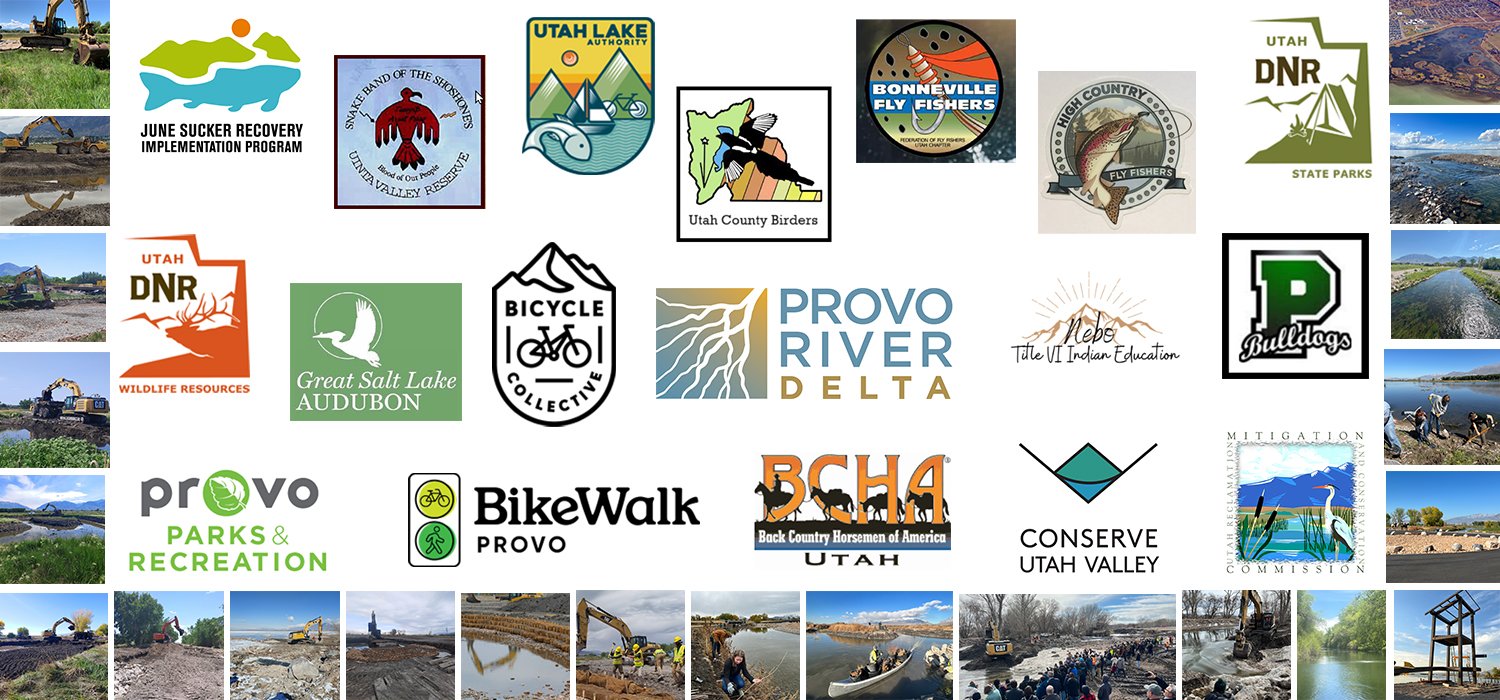
Recreational Amenities Hit the Spot
Loop trail and Pedestrian Bridge: The existing Skipper Bay Trail was expanded and paved along the southern delta boundary and benches were installed. A pedestrian bridge was constructed to connect this to the Provo River Parkway trail along the original Provo River channel, creating an over 3-mile loop trail.
Viewing Tower: a new viewing tower was constructed along the Skipper Bay Trail near the delta’s interface with Utah Lake.
New Skipper Bay Trailhead: A new trailhead was constructed along the delta’s Skipper Bay trail expansion. The trailhead includes a parking lot, vault restroom, boat ramp, bike rack and interpretive signs.
Delta Gateway Park: Provo City began construction of the new Delta Gateway Park near Lakeshore Drive with direct access to both the Provo River’s original channel and the restored delta. The park will feature a nature-focused playground, shades, trail and interpretive exhibits. The Delta project funded land acquisition, design, and construction of the park. Provo City started construction the summer of 2024 and will own and manage the park when completed in 2025.
Interpretive Exhibits: Educational signs were developed, fabricated and installed at key points in the Delta Project area, including along the original channel, and will be installed in the new Delta Gateway Park when its construction is complete.
Local Community Loads on the Love
The love kept rolling in as volunteers showed up strong for our 2024 community events. Participation in our 2nd Saturday delta site tours and community work parties surpassed the previous year’s numbers once again. In 2024, 487 enthusiastic volunteers contributed 766 hours weeding, seeding, planting willows and picking up truckloads of trash. In addition, almost 2,000 community members of all ages got a sneak peek at the delta before it officially opened and learned about the unique June sucker through more than 24 guided tours and 26 outreach events. We love all the local community and student volunteers who have dug in to get the restored delta off to great start!
Didn’t Forget Your Greens
Each year of delta construction 2020-2023 was followed by a massive revegetation effort involving hydromulching, seeding and planting to ensure native vegetation took root in the restored habitat. In 2020 as the project was ramping up, we planted 30,000 native plants and seeded disturbed areas; in 2021, we installed almost 58,000 plants and seeded over 10 acres; in 2022, we planted 75,000 native plants and seeded 23 acres; and, in 2023 when major construction was being completed in the delta, we installed 100,000 native plants and seeded 35 acres. While project construction in 2024 primarily entailed building recreational features, involving less soil disturbance, revegetation efforts continued as we planted about 25,000 native plants and seeded primarily along the delta’s south shore and riverine islands.
Minding the Nursery
With the delta in full operational mode in 2024, multifaceted monitoring efforts continued to ensure the delta’s crucial habitat supports the June sucker, and to determine how other flora and fauna react to area changes. June sucker monitoring covered adult spawning, larval production and drift, and juvenile occurrence and growth. In addition, fixed PIT tag antennas were installed in each of the Delta’s four outflow channels so that June suckers implanted with microchips, called Passive Integrated Transponder (PIT) tags, can be more easily tracked as they enter and exit the Delta. The Delta was also monitored for nonnative fish so their effects on young June sucker could be tracked, and common carp were monitored and controlled to prevent them from negatively impacting June sucker habitat.
Researchers from Utah State University monitored aquatic vegetation in the delta to better understand the vegetation present, its growth patterns, and how the vegetation will provide habitat needed for young June sucker to evade predation by nonnative fish. Other work included an ongoing bird monitoring and movement study, mosquito monitoring and control, water quality monitoring, and monitoring for two important plant species known to occur in the Utah Lake area including the bog violet and the Ute ladies’-tresses.
Attention to Provo River’s Original Channel
Diversion Structure: A diversion structure was constructed on the south bank of the Provo River, upstream from Lakeview Parkway, to divert a portion of Provo River water from the new delta channel and into the river’s original lower channel. During high runoff last spring, we experienced clogging of this structure due to high sediment volumes in the river and other debris (shopping carts, carpet, tarps, etc) collecting against the diversion. Options were explored to redesign the structure’s intake in order to address these issues, with the plan of completing the modifications in 2025.
Small Downstream Dam: We continued construction in 2024 of a small dam in the downstream end of the original Provo River channel, near Utah Lake State Park, to support recreation through this reach. A preliminary structure was constructed, and the area was “pre-loaded” with materials to consolidate soft soils. This foundation was left to settle through the remainder of the year so the foundation can support a more substantial engineered dam structure to be constructed in 2025.
Aeration System: We have been operating an aeration system in the original channel since July of 2023. This system consists of two aeration types and was installed to maintain adequate dissolved oxygen levels. Testing of the aeration system has involved regular water quality sampling of the original channel. In 2023, this testing showed the need to increase the number of diffusers (or bubblers), which was done in June 2024, bringing the total number of diffusers to 36. Water quality monitoring shows the additional diffusers are supporting improved dissolved oxygen conditions through a much larger area of the channel.
2025 Finishing Touches and Management
Construction of new recreational amenities on the original channel are scheduled for completion in 2025.
Boat Ramps and Fishing Platforms: As shown in the map, construction of three new fishing platforms and two non-motorized boat ramps - one at Alligator Park, and the other at the trailhead near Utah Lake State Park – is scheduled for the fall of 2025. This work will require use of heavy equipment and includes removal of five trees/stumps that obstruct the installation at two sites along the channel, and removal of other woody debris that interfere with channel navigation. Trail users should expect periodic closures until all recreation features along the channel are constructed.
Delta Gateway Park Completion: Provo City is expected to complete construction of the Delta Gateway Park in June 2025.
Trail Paving: The Delta project provided funding to Utah County to repave the trail along the original channel from Lakeshore Drive to Utah Lake State Park. Currently, this paving work is anticipated to take place in 2025. The trail along the original channel connects to the expanded Skipper Bay Trail through a constructed pedestrian bridge to create an over 3-mile loop.
Small Downstream Dam Completion: Crews will return to complete the small dam at the downstream end of the original channel this spring and summer. The small dam, revegetated banks and associated recreation features will be completed in 2025.
Diversion Structure Reconfiguration: Crews are working on the diversion structure’s reconfiguration to reduce clogging and allow adequate flow deliveries at various Provo River levels. Construction is expected to be complete in March 2025.
Aeration System: We will continue monitoring and testing and will evaluate whether additional changes to the system are needed.
Management
In the coming years, the original channel will be managed by Utah Division of Wildlife Resources as a community fishery. UDWR will be evaluating the channel to determine what fish species will be appropriate for the area and develop any necessary fishing regulations. With the work planned for this area, we anticipate the channel to continue to support recreation and be an amenity for those who use the Provo River trail.
The delta will be managed as a multi-use recreation area, for which a management plan is being developed. Utah County operates and manages the new trails and trail amenities, gates, viewing tower and new Skipper Bay Trailhead. Utah Division of Wildlife Resources (UDWR) owns and manages the delta partially as a Waterfowl Management Area, open to fishing and waterfowl hunting. Anglers and boaters should be aware the Utah Wildlife Board has approved 2025 fishing regulations for the area and only nonmotorized boats are allowed in the delta. Hunters should note that a large portion of the delta is designated a no-shooting zone.
The No Shooting Area (safety zone) exists to ensure the safety of all those in the delta, nearby Provo High School, and adjacent private properties. Respecting the safety zone and private property boundaries will help ensure the future of hunting on the Provo River Delta. Visitors will find many large, easy-to-spot signs that identify the hunt area boundaries within the delta, as well as multiple maps and signs along the trails to serve as a reminder that hunting is allowed only in specific areas.
How Did We Get Here?
Review the past four years of project construction and see how far we’ve come!
Like the photos? View new photos in our Photo Gallery!
